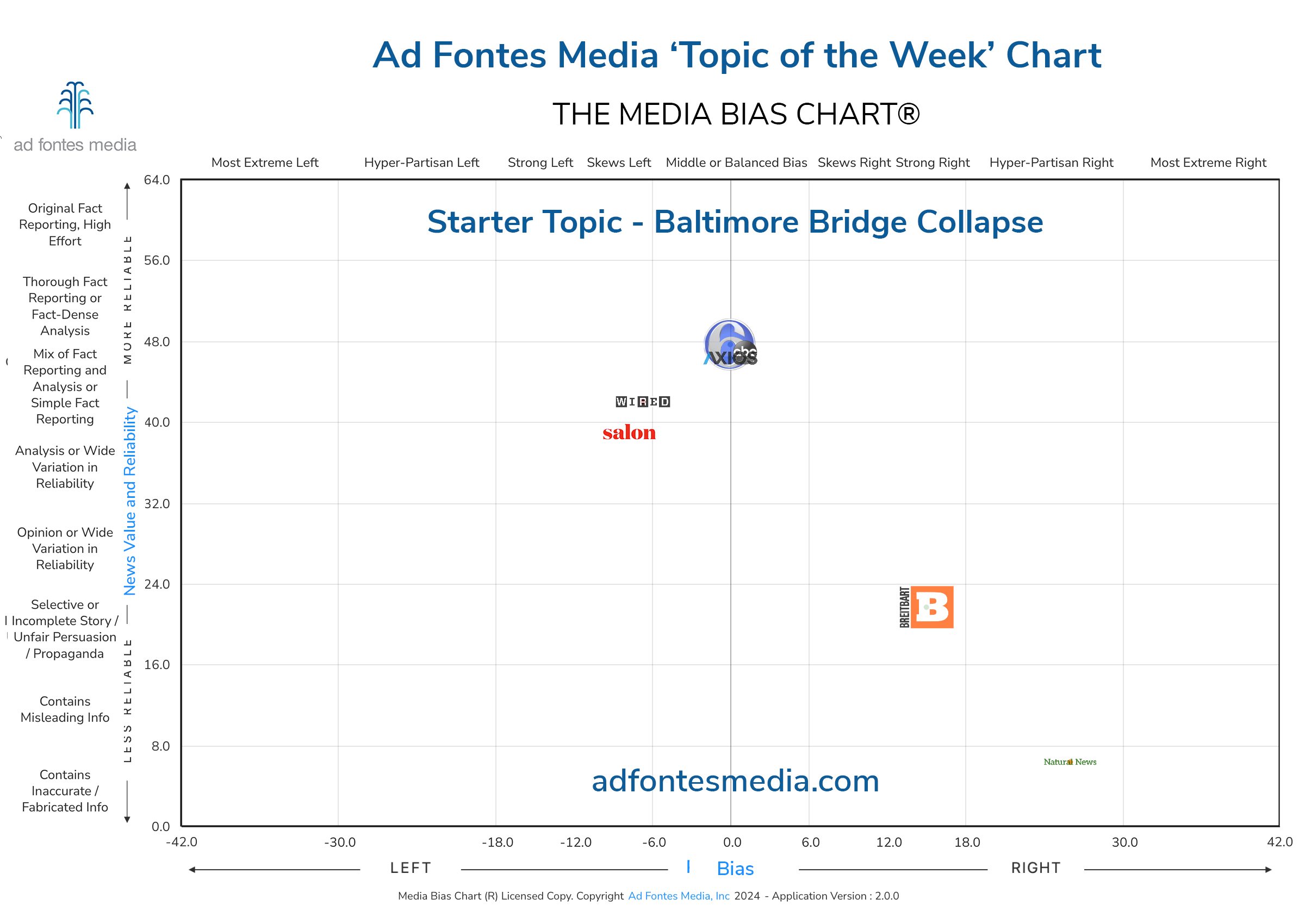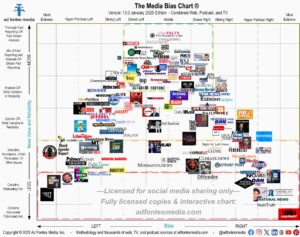
Key Bridge Collapses in Baltimore, and Conspiracy Theories Abound
Author:
Sara Webb
Date:
04/05/2024
In the early hours of Tuesday, March 26, a cargo ship lost power as it was approaching the Francis Scott Key Bridge in Baltimore, Maryland. It strayed out of the shipping lanes and struck a key support pillar, plunging the bridge, along with several vehicles and people, into the frigid Patapsco River. Our analysts examined coverage of this tragedy in our Topic of the Week.
Each week, Ad Fontes Media chooses a widely covered trending news topic to share insight into how our analysts rank news coverage for the Media Bias Chart®. To do this, we select six articles reporting on the same story from different outlets to show how each treated the subject.
Once we choose a set of articles, pods of analysts with diverse political perspectives (one right leaning, one center, and one left leaning) read each article and use Ad Fontes Media’s content analysis methodology to determine its bias and reliability. These ratings inform the articles’ placement on that week’s special Media Bias Chart®.
Our analyst team took a closer look at several articles about the bridge collapse from various media outlets last week: “Baltimore bridge collapse: Biden administration approves $60M for bridge costs” from 6ABC, “What to know about the ripple effects of the Baltimore bridge collapse” from Axios, “Online Conspiracies About the Baltimore Bridge Collapse Are Out of Control” from WIRED, “Buttigieg Mess: Transportation Dept Will Not Say How Many National Defense Ships Stuck in Harbor” from Breitbart, “Right-wingers blame the Baltimore bridge collapse on everything short of the Mothman” from Salon, and “Francis Scott Key Bridge collapse an “absolutely brilliant strategic attack,” say multiple intel sources” from Natural News. While the bias and reliability scores for each of these articles can be found on our Topic of the Week page, we are going to talk about three that discuss conspiracy theories.
The Wikipedia entry on conspiracy theories says that they are “an explanation for an event or situation that asserts the existence of a conspiracy by powerful and sinister groups, often political in motivation, when other explanations are more probable.” If you want a deeper dive, Ad Fontes Media founder Vanessa Otero recorded an online lecture on “How to Spot Conspiracy Theories” in 2020 that examines conspiracy theories using the rhetorical techniques that our analysts employ when rating articles for bias and reliability.
Three articles from this week’s set — from WIRED, Salon, and Natural News — specifically call out conspiracy theories. Let’s take a closer look.
WIRED is a print and online magazine launched in 1993 that focuses on technology, business, culture and science. Its aggregate score for bias is -7.34 (skews left) and for reliability is 36.63 (analysis or wide variation in reliability). This week’s article was rated at -6.67 for bias (skews left) and 42 for reliability (mix of fact reporting and analysis).
This article is the longest of the three, and the most dense. “Conspiracists and far-right extremists are blaming just about everything and everyone for Tuesday morning’s Baltimore bridge collapse. A non-exhaustive list of things that are getting blamed for the bridge collapse on Telegram and X include President Biden, Hamas, ISIS, P. Diddy, Nickelodeon, India, former president Barack Obama, Islam, aliens, Sri Lanka, the World Economic Forum, the United Nations, Wokeness, Ukraine, foreign aid, the CIA, Jewish people, Israel, Russia, China, Iran, Covid vaccines, DEI, immigrants, Black people, and lockdowns.”
Is there evidence that any of the items or people on this list were culpable for the bridge collapse? No. But is that part of the allure of a conspiracy theory? Absolutely.
The WIRED article also talks about a “black swan event,” which will come up again in the other articles this week. The article explains that the term “has been around for decades and is used to describe a major global event (typically in the financial markets) that can cause significant damage to a country’s economy. But in recent years, the term has been co-opted by the conspiracy-minded to explain an event triggered by the so-called deep state that would signal an imminent revolution, a third world war, or some other apocalyptic catastrophe.” The article describes Marjorie Taylor Greene as “an influential and conspiracy-minded member of the GOP,” which accounts for the bias rating of “skews left” from our analysts.
Salon is a news and opinion website created in 1995, one of the first all-digital media outlets. Its aggregate score for bias is -14.4 (strong left) and reliability is 32.17 (analysis or wide variation in reliability). This week’s article was rated at -8.67 for bias (skews left) and 38.33 for reliability (analysis or wide variation in reliability). The subheading for this article calls out that from “lax immigration policy to cyberattacks, Tuesday’s Francis Scott Key Bridge tragedy led to wild finger-pointing,” and the brief article seeks to explore why.
The article says that Fox News’ Maria Bartiromo suggested that “a ‘wide open’ immigration policy at the border could be a factor” since the cargo ship had been flying under a Singaporean flag, and that Alex Jones, who famously denied that the Sandy Hook school shooting had taken place, supported a theory that the ship was “cyberattacked,” adding that “WW3 has already started.”
Bold words meant to rouse his audience? Yes. But if we take a page from Otero’s lecture linked above, in order for a targeted cyberattack to have caused the crash, a large number of events would have had to converge, making it an unlikely explanation. And as to World War III, no declarations have yet been made. The “skews left” bias score assigned to this article is for blaming “right-wingers” for all of the conspiracy theories out there.
Natural News is a blog that features articles about science and health. Launched in 2008, its motto is “defending health, life and liberty,” and its content has been cited as being false and based on conspiracy theories. Its aggregate score for bias is 28.5 (hyper-partisan right) and reliability is 9.21 (contains misleading info). This week’s article was rated at 26 for bias (hyper-partisan right) and 6.33 for reliability (contains inaccurate/fabricated info).
This article cites “multiple intelligence sources” but in actuality is based on a post on X from Lara Logan, a South African journalist and war correspondent who became “the voice of the far right” mid-2023. The quote itself cites “multiple intel sources” who apparently provided enough information for her to ascertain that the “attack” was “perfectly targeted” and that “they” have figured out a way to bring “us” down.
Referring back to Otero’s presentation again, one of the hallmarks of a conspiracy theory is a shadowy, unnamed organization that pulls the puppet strings. The Natural News article closes with a quote from Logan: “‘All these factors when you look at it – this is how you teach people how to do this type of attack and there are so few people left in the system who know this. We have a Junior varsity team on the field.’”
There is a lot to pick apart in that statement, but Otero explains that one of the best ways to identify a conspiracy theory is to use your common sense. Which team is she talking about that is Junior varsity? Which system lacks the people that know how to pull off the kind of attack but that a journalist spotted with ease? This article was rated “hyper-partisan right” for its implication that the current government is the cause of the “free-fall” that America is experiencing.
These are just a few examples of the thousands of articles our analysts have rated for reliability and bias. If you want a look at the larger media landscape or are curious to see how our analysts have rated your favorite sources, head on over to our website and check out the resources we have available. And don’t forget to come back for another examination of our Topic of the Week.
If you want to stay informed on all of our amazing work, join our free mailing list!


